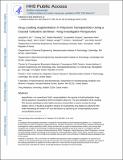| dc.contributor.author | Cai, Truong H. | |
| dc.contributor.author | Mandaric, Stefan | |
| dc.contributor.author | Chopra, Sunandini | |
| dc.contributor.author | Langer, Robert S | |
| dc.contributor.author | Karnik, Rohit | |
| dc.date.accessioned | 2020-05-19T14:40:15Z | |
| dc.date.available | 2020-05-19T14:40:15Z | |
| dc.date.issued | 2019-03 | |
| dc.identifier.issn | 0021-9797 | |
| dc.identifier.uri | https://hdl.handle.net/1721.1/125309 | |
| dc.description.abstract | Hypothesis: In conventional ‘bulk’ nanoprecipitation, the capacity to load hydrophobic drugs into the polymeric nanoparticles (NPs) is limited to about 1%. The size distribution of the resulting NPs becomes polydisperse when higher precursor concentration is used to increase the drug loading. Hence, it should be possible to enhance the hydrophobic drug loading in polymeric NPs while maintaining the uniform NP size distribution by optimizing the nanoprecipitation process and purification process. Experiments: Systematic studies were performed to enhance the loading of docetaxel (Dtxl) by using a process of centrifugal spin-down, rapid mixing by turbulence, and addition of co-solvent. The size distributions and Dtxl loading of the NPs were measured using dynamic light scattering and HPLC, respectively. Findings: The centrifugal spin-down process helps to maintain uniform size distribution even at the high precursor concentration. In bulk nanoprecipitation, the resulting NPs achieved Dtxl loading up to 3.2%. By adopting turbulence for rapid mixing, the loading of Dtxl increased to 4.4%. By adding hexane as co-solvent, the loading of Dtxl further increased to 5.5%. Because of the drug loading augmentation, high degree of control, and extremely high production rate, the developed method may be useful for industrial-scale production of personalized nanomedicines by nanoprecipitation. | en_US |
| dc.description.sponsorship | National Institutes of Health (U.S.) (Grant EB015419) | en_US |
| dc.description.sponsorship | National Institutes of Health (U.S.) (Grant CA119349) | en_US |
| dc.description.sponsorship | Center of Cancer Nanotechnology Excellence at MIT-Harvard (National Cancer Institute (U.S.)) (Grant U54-CA151884) | en_US |
| dc.language.iso | en | |
| dc.publisher | Elsevier BV | en_US |
| dc.relation.isversionof | 10.1016/J.JCIS.2018.11.029 | en_US |
| dc.rights | Creative Commons Attribution-NonCommercial-NoDerivs License | en_US |
| dc.rights.uri | http://creativecommons.org/licenses/by-nc-nd/4.0/ | en_US |
| dc.source | PMC | en_US |
| dc.title | Drug loading augmentation in polymeric nanoparticles using a coaxial turbulent jet mixer: Yong investigator perspective | en_US |
| dc.type | Article | en_US |
| dc.identifier.citation | Lim, Jong-Min et al. “Drug loading augmentation in polymeric nanoparticles using a coaxial turbulent jet mixer: Yong investigator perspective.” Journal of Colloid and Interface Science 538 (2019): 45-50 © 2019 The Author(s) | en_US |
| dc.contributor.department | Massachusetts Institute of Technology. Department of Chemical Engineering | en_US |
| dc.contributor.department | Massachusetts Institute of Technology. Department of Mechanical Engineering | en_US |
| dc.contributor.department | Massachusetts Institute of Technology. Department of Biological Engineering | en_US |
| dc.contributor.department | Koch Institute for Integrative Cancer Research at MIT | en_US |
| dc.relation.journal | Journal of Colloid and Interface Science | en_US |
| dc.eprint.version | Author's final manuscript | en_US |
| dc.type.uri | http://purl.org/eprint/type/JournalArticle | en_US |
| eprint.status | http://purl.org/eprint/status/PeerReviewed | en_US |
| dc.date.updated | 2020-03-17T16:35:01Z | |
| dspace.date.submission | 2020-03-17T16:35:03Z | |
| mit.journal.volume | 538 | en_US |
| mit.license | PUBLISHER_CC | |
| mit.metadata.status | Complete | |
